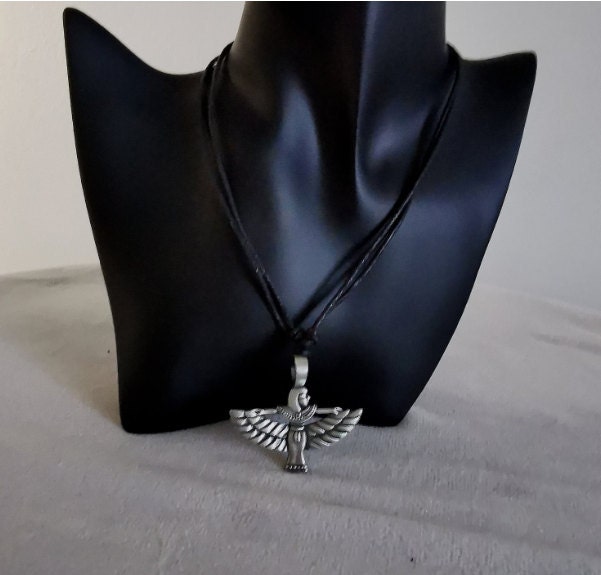Isis, whose name means "throne" in ancient Egyptian, is often depicted as a woman with a throne-shaped crown on her head, symbolizing her role as the queen of the gods and a protector of the Pharaoh. She is a member of the Heliopolitan Ennead, the group of nine deities worshipped primarily in the city of Heliopolis, but her reach extended far beyond this center. In Egyptian mythology, she is the daughter of the earth god Geb and the sky goddess Nut, making her a central figure in the divine family. Isis is best known for her role as the wife of Osiris and the mother of Horus. Osiris, the god of the afterlife, was killed by his brother Set, the god of chaos. According to the myth, Set trapped Osiris in a coffin and threw it into the Nile, where it was carried away and became the base of a tree. Isis, devastated by the loss of her husband, embarked on a long and arduous journey to find his body. When she finally did, she brought him back to life with the help of powerful magic. This act of resurrection is central to the myth of Osiris, which explains the cycles of death and rebirth, and it was believed that through the magical power of Isis, the soul could be rejuvenated in the afterlife.
One of the most defining characteristics of Isis is her mastery of magic and healing. She was considered the greatest of all the magical deities in Egyptian religion. In the myth of Osiris, Isis’s ability to use magic was essential in restoring Osiris to life. It is believed that her magic could also protect the living from danger, cure ailments, and ensure the prosperity of Egypt. The magical prowess of Isis was not confined to her role in the Osiris myth. She was invoked in spells for protection and healing, and her knowledge of herbal medicine and incantations made her the patroness of healers and physicians. In some texts, Isis is said to have invented writing and was credited with teaching humanity the secrets of magic. Her association with magic extended beyond Egypt and was also shared by other cultures, who viewed her as a powerful goddess capable of bringing about transformation in both the physical and spiritual realms.
Isis is also an iconic figure in the domain of motherhood. As the mother of Horus, the falcon-headed god of kingship, she became a symbol of the ideal mother—loving, nurturing, and protective. The image of Isis suckling her child Horus became a popular motif in Egyptian art and was adopted by many cultures across the ancient world. Her maternal qualities extended to her role as a protector, especially in the afterlife. In funerary texts, Isis was invoked to safeguard the deceased and ensure a safe passage to the afterlife. She was believed to offer protection to the soul, guiding it through the dangers of the underworld and helping it attain eternal life. The "Isis-Adept" was often an epithet used for those who sought her assistance in the afterlife, reflecting the goddess’s role as a comforting, guiding presence for souls. Isis’s protective nature was not limited to the dead. She was also a guardian of kings and of the Egyptian people. Pharaohs, as the earthly embodiments of Horus, were considered her direct representatives. In royal inscriptions and monuments, Isis is often shown as a guardian of the throne, symbolizing her importance in maintaining the stability and strength of the kingdom. Her connection to the kingship of Egypt made her a powerful and respected figure among the ruling class.
While Isis’s cult began in Egypt, it quickly spread across the ancient world, particularly during the Ptolemaic period (circa 300-30 BCE), when Egypt was ruled by Greek monarchs. The Ptolemies were keen to integrate Egyptian religious traditions into their own, and Isis’s worship became an important aspect of their political and cultural life. As a result, temples to Isis were constructed not only in Egypt but also in other parts of the Mediterranean, including Greece, Rome, and Asia Minor. The spread of Isis's cult can be seen in the widespread adoption of her image and iconography. Her worship became particularly popular in the Roman Empire, where she was often invoked as a goddess of fertility and healing. The Roman emperors themselves took part in her cult, and her temples were constructed in major Roman cities, including Rome itself. Her influence also reached into the farthest corners of the empire, with evidence of her worship found in Britain and North Africa. One of the reasons for her widespread appeal was her association with the idea of universal protection. Unlike some gods who were tied to specific places or peoples, Isis was seen as a deity who could transcend borders and offer help to anyone who called upon her. She was often seen as a goddess who could provide solace in times of hardship, making her especially popular during periods of uncertainty or crisis. This universal aspect of her worship allowed her to integrate into the diverse religious practices of the Mediterranean world.
Although the official worship of Isis began to decline with the rise of Christianity, her legacy continues to be felt today. The symbolism of Isis as a powerful and loving mother, protector, and goddess of magic has influenced various religious and spiritual traditions. For instance, the image of Isis nursing her child Horus was later adopted by early Christians to represent the Virgin Mary and the Christ child, showing the continuity of maternal imagery across cultures. Moreover, Isis’s association with magic and wisdom has made her a symbol of female empowerment in modern times. Her ability to transcend the traditional roles of women in ancient societies, taking on roles of power, wisdom, and agency, has made her an enduring figure in feminist spiritual movements. Her attributes—intelligence, strength, and resilience—continue to inspire those seeking to challenge conventional ideas of gender and power.


